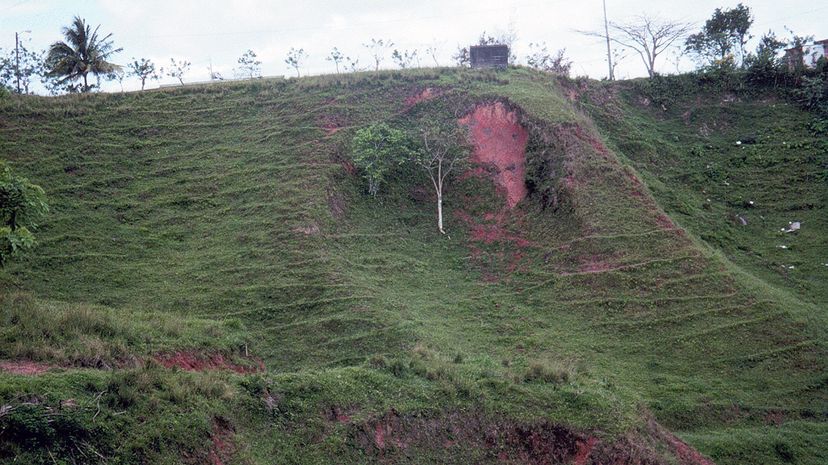People and Landslides

Humans make landslides more likely through activities like deforestation, overgrazing, mining and road-building. Remember when we explained that vegetation acts like glue, holding the soil in place? These activities rob that glue from the land, increasing the probability of a landslide. For example, landslides are much more likely to occur in mountainous areas that have been clear-cut. We may have seen this unfold in 2014, when a landslide hit the Indian village of Malin, killing at least 151 people. Previously, thousands of trees in the neighboring hills had been chopped down to make room for new farms, construction projects and mining operations [source: Sarvade et al.].
By the way, you've probably seen signs warning of rock falls if you've ever driven through the mountains. The drop-offs with loosened soil on both sides of manmade roads require much less water to set off a landslide than natural drop-offs.
Advertisement
Although landslides cannot be avoided entirely, people can do several things to discourage them. Drainage pipes installed into slopes can carry away excess water, and impermeable membranes like plastic sheeting can prevent water from building up and dislodging the soil. In addition, setting up retaining walls at intervals will catch loose debris and keep it in place, while removing excess mass from the top of a slope could prevent the bottom from giving way. Reforestation is a good deterrent to landslides as well.
Perhaps the most important thing people can do to avoid the dangers of landslides is to avoid building in hazardous zones. Ideally, buildings shouldn't be placed on steep slopes or in drainage areas. But if people do build in areas like these that are susceptible to landslides, they should use protective measures. For instance, construction sites should use barriers to mitigate runoff and erosion [source: Kansas Geological Survey].
If you find yourself in an area where landslides are likely, be ready with an emergency evacuation plan. Be aware of any sudden rises or falls in water flow and listen for sounds that may signal moving debris or falling rocks. If you suspect landslide activity, you should evacuate immediately if it is safe to do so. Remember to be especially vigilant when driving, as roadside embankments are also hazardous.
Related Articles
Sources
- American Geosciences Institute. "How Much Do Landslides Cost the U.S. In Terms of Monetary Losses?" https://www.americangeosciences.org/critical-issues/faq/how-much-do-landslides-cost-terms-monetary-losses
- Brantley, Steve, and Bobbie Myers. "Mount St. Helens -- From the 1980 Eruption to 2000." USGS. March 21, 2005. http://pubs.usgs.gov/fs/2000/fs036-00/
- Biek, Robert, Hacker, David, and Rowley, Peter. "Update on the Markagunt Gravity Slide: Utah's Largest Landslide Just Got Bigger -- A Lot Bigger." Utah Geological Survey. January 2016. https://geology.utah.gov/map-pub/survey-notes/update-markagunt-gravity-slide/
- Davies, H.L., Davies, J.M., Perembo, R.C.B., and Lus, W.Y. "The Aitape 1998 Tsunami: Reconstructing the Event From Interviews and Field Mapping." Pure and Applied Geophysics vol. 160, no. 10-11, October 2003. https://nctr.pmel.noaa.gov/PNG/Upng/Davies020411/
- Exline, Joseph D., ed. "Science Explorer: Earth's Changing Surface." Teacher's Ed. Prentice Hall. 2002.
- Feather, Ralph M. Jr. et al. "Earth Science." Georgia Teacher Wraparound Ed. Glencoe/McGraw-Hill. 2002.
- Highland, Lynn M., et al. "Debris Flow Hazards in the United States." United States Geological Survey, June 23, 2003. http://pubs.usgs.gov/fs/fs-176-97/fs-176-97.html
- Highland, Lynn. "Landslide Types and Processes." USGS. July 2004. http://pbs.usgs.gov/fs/2004/3072/
- Kansas Geological Survey. "Prevention and Remediation of Landslides." April 1999. http://www.kgs.ku.edu/Publications/pic13/pic13_5.html
- Maton, Anthea et al. "Dynamic Earth." Annotated Teacher's Ed., Prentice Hall. 1994.
- Neuman, Scott. "In U.S., Mudslides Common, But Usually Few Deaths." National Public Radio. March 28, 2014. https://www.npr.org/sections/thetwo-way/2014/03/28/295823075/in-u-s-mudslides-common-but-usually-few-deaths
- NPS Park Geology Tour. "What's the Difference Between Weathering and Erosion?" National Park Service. 1999. https://www.nature.nps.gov/geology/usgsnps/misc/gweaero.html
- Petley, D. N. "Global Patterns of Loss of Life From Landslides." Geology vol. 40, no. 10, October 2012. https://pubs.geoscienceworld.org/gsa/geology/article-abstract/40/10/927/130722/global-patterns-of-loss-of-life-from-landslides?redirectedFrom=fulltext
- Sarvade, Shivaji, Sarvade, M.M., Khadatare, P.S., and Kolekar, M.M. "30/7 Malin Landslide: A Case Study." Paper presented to the National Conference "GEPSID" at Ludhiana. October 2014. https://www.researchgate.net/publication/320124781_307_MALIN_LANDSLIDE_A_CASE_STUDY
- United States Geological Survey Landslide Hazard Program. "Frequently Asked Questions." Sept. 17, 2007. http://landslides.usgs.gov/learning/faq/#q03
- United States Geological Survey. "Landslide Hazards." May 2000. http://pubs.usgs.gov/fs/fs-0071-00/fs-0071-00.pdf
- United States Geological Survey. "Types of Landslides." July 2004. https://pubs.usgs.gov/fs/2004/3072/pdf/fs2004-3072.pdf
- Washington Geological Survey. "What Are Landslides and How Do They Occur?" April 11, 2017. https://www.dnr.wa.gov/publications/ger_fs_landslide_processes.pdf